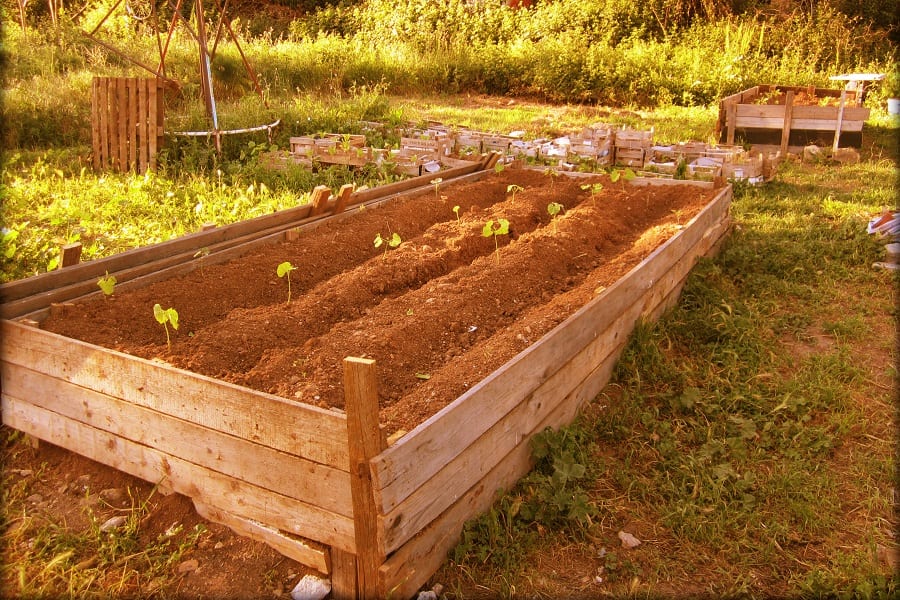You might love eating lasagna, but did you know that there’s a type of gardening called “lasagna gardening?”
Whether you’re just starting out with your gardening hobby or you’ve got green fingers, you’ll love trying it out.
What, exactly, is lasagna gardening?
Lasagna gardening is a gardening method that’s focused on putting in less effort while achieving healthy garden soil by layering organic matter on the ground.
That, now, makes sense as to why this method is called lasagna gardening! If the idea of a low-maintenance yet healthy garden sounds appealing to you, read on to learn everything you need to know about lasagna gardening.
Table of Contents
What You Need To Start A Lasagna Garden
If you want to grow healthy plants and veggies, you know that soil is the most important element. It needs to be full of nutrients so that plants get what they need to grow and thrive. But it’s not always easy to get healthy soil without a lot of effort, such as tilling and digging the soil.
Not only can it be expensive to have the right tools to encourage a healthy, thriving garden, but it’s time-consuming to achieve. For some people, such as those with no gardening expertise or busy schedules, it can be completely overwhelming.
A lasagna garden doesn’t require a lot of effort or tools, which is why it’s so appealing to people who don’t have green fingers or the tools required to invest in gardening. So, if you don’t need to dig or till, then what do you need to be able to start a lasagna garden?
In order to answer that question, it’s important to understand that this type of garden has healthy soil because it encourages the growth of microorganisms.
You’ll achieve this by creating layers of organic matter that help to nourish the soil and make it healthy enough for plants to grow in it.
It’s clear to see that this method of gardening is highly sustainable because you can use organic materials, such as household or garden waste, in the layers!
Here are things you can safely use to create the layers of your lasagna garden:
- Grass clippings
- Fruit and vegetable scraps
- Leaves
- Coffee grounds
- Tea leaves and bags
- Weeds
- Compost
- Pine needles
- Peat moss
- Cardboard
- Newspaper
You probably have many of these types of organic matter in your home and garden, and now you can make great use of them.
In addition to organic matter, to be able to set up your own lasagna garden, you’ll also need the right spot in your garden – but we’ll get to that!
Benefits Of Lasagna Gardens
Being able to prevent waste in your household is a fantastic benefit of creating your own lasagna garden, but this type of garden has other benefits. These include:
- Healthier soil. Since it makes use of organic material in a similar way to compost, a lasagna garden enables the soil to better absorb and hold onto water as compared to regular garden soil.
- A lasagna garden creates loose soil. This makes it much easier to plant in it and work with it, especially if you’re new to gardening.
- You don’t need to use a lot of fertilizer because the organic materials will create a compost that’s full of healthy nutrients.
How To Build Your Lasagna Garden
Ready to start a lovely lasagna garden? Here are the steps you should follow.
Determine Where To Put Your Garden
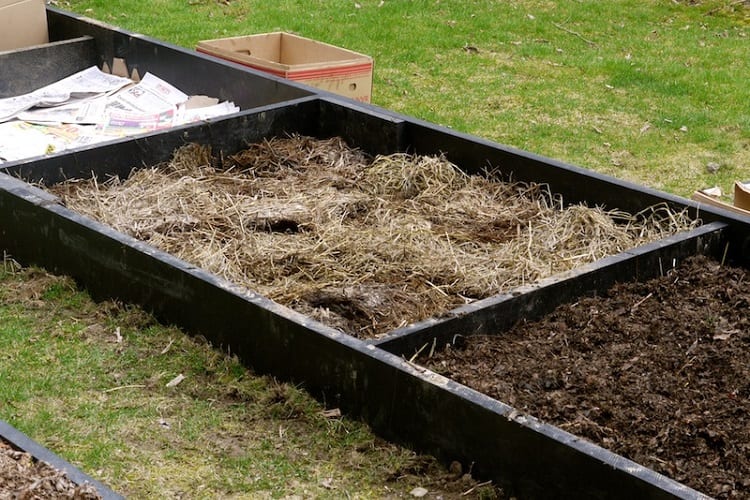
Before you start creating the layers for your garden, you will need to determine where you want it to be on your property and how large you want it to be.
The plants you wish to grow in your lasagna garden will influence the size of it and perhaps even where it’s placed. There are other things to consider when it comes to finding the right spot for your lasagna garden.
- Make sure it’s on level ground. This will prevent soil erosion and water runoff.
- The area should get a minimum of six hours of sunshine every day.
- The area must never be in the way of strong winds. These could be damaging to your plants when they grow.
- The ground in the area needs to drain well. You should never set up your garden in a spot where water puddles!
Will you have one or more lasagna gardens?
You can have one lasagna garden or many small ones. If you’re going to be separating your lasagna garden from the rest of your property, you’re probably going to want it to look neat and tidy.
You might want to create a border around it, such as with the use of logs. However, be warned that some wood can be toxic. These types include locust and cherry. The safest wood types to stick to include maple, oak, and pine.
If you’re using wood to separate different lasagna beds, you should avoid making use of pressure-treated lumber as this contains dangerous chemicals that will enter the bed.
A good idea is to separate different beds by placing down a path of cardboard between them. This will make it easier for you to have access to all the beds while it will prevent weeds from being able to grow and become a nuisance.
Collect Your Organic Matter
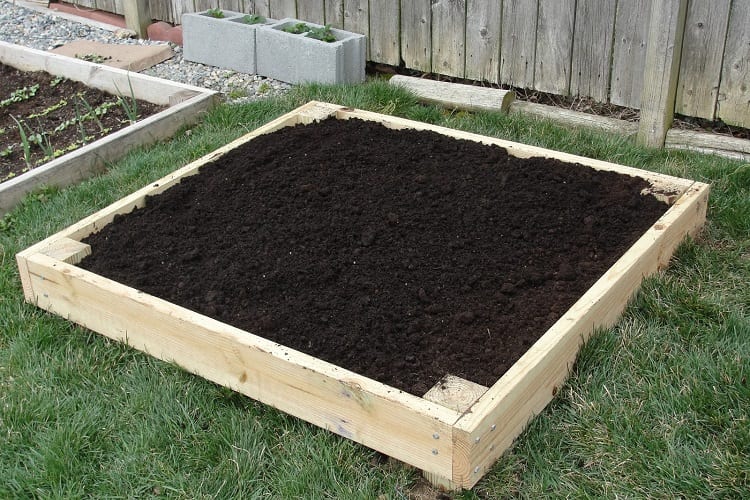
Once you’ve determined where the lasagna garden will grow, you can collect your organic matter and place it in the garden.
Now, it’s important that you don’t just take organic matter in its natural state and throw it into the garden. You should take the time to cut it up so that it’s in smaller pieces. This is so that it will decompose easier and faster.
Set Down The First Layer
Now, you can’t just throw your organic matter in this lasagna bed in a big pile. You have to layer it correctly. So, the first layer that you should put on the ground is your newspaper or cardboard layer. These don’t have to be cut up before being used.
The reason why these are essential to your garden is because they will act as ground cover, preventing weeds from growing. Don’t worry about them from a sustainable front – they will decompose in the ground!
Besides cardboard and newspaper, other “brown materials” can be used in this layer of organic matter, such as pine needles and dry leaves (which you should chop up for them to get broken down easier).
After putting this layer onto the soil, you should wet it with some water. This will help it to start decomposing. It’s a good idea to sprinkle some peat moss on top of the cardboard or newspaper, too. Aim for a layer of peat moss that’s between two and three inches thick.
Sprinkle Bone Meal And Wood Ash
After you have put down your first layer, you should sprinkle bone meal and wood ash all over it. This brings nutrients such as potassium to the soil.
Then, water the layer before you move on to the next step. It’s also important to sprinkle these items after every layer that you put on your lasagna garden.
Do A Second Layer
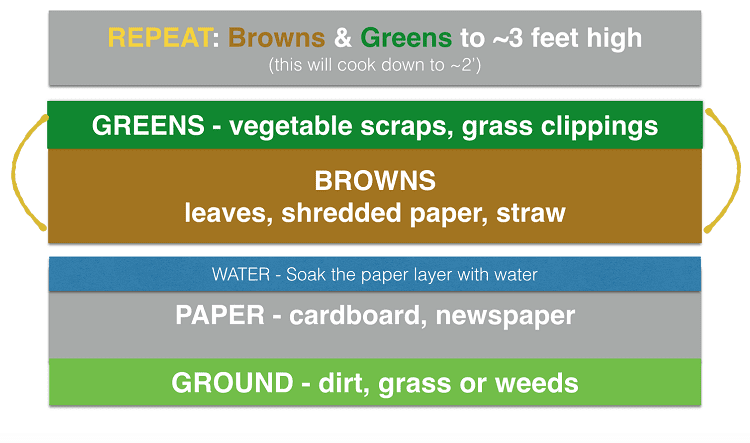
Now that you’ve got your first layer, your second layer should be made up of organic materials that absorb water. These are known as “green materials,” such as dry grass clippings and vegetable scraps.
These help to contribute to the nitrogen requirements of the soil. Make sure this layer is around three inches thick, and you can definitely cut these up into smaller pieces to make them decompose easier.
After you’ve put this layer down, add a sprinkle of bone meal and wood ash, and then water it, just like you did with the previous layer.
Finish With A Third Layer
For the third layer, you want to focus on around eight inches of organic material. Use grass clippings and compost in this layer, as these will help to boost the growth of microorganisms, an essential part of the garden.
Once you’ve got your third layer, you will need to sprinkle the bone meal and wood ash, and then lightly water it again!
Going forward, you must always ensure that the lasagna garden is a bit moist but not too wet, as that can cause the materials to rot. Think of it in a similar way to composting.
If the weather is severely dry, you should lightly water your lasagna garden so that the organic matter doesn’t dry out. So, just keep an eye on it now and then to be sure that it’s getting enough water.
Repeat The Layers If Required
If you want the lasagna garden to be higher, you can repeat the three layers to make it larger and taller.
Use A Cover Crop
Once you have the lasagna garden at the height you want, you need to plant a cover crop in this garden. You can choose something like rye or crimson clover, as both are good choices. This cover crop is important as it will ensure that the garden is protected over the winter months.
It’s a good idea to start your lasagna garden during the fall as this gives all of its organic materials the chance to properly break down during the winter months.
The benefit of creating your lasagna garden during this season is that you’ll be able to make use of all the brown materials that you need, such as fallen leaves.
When Can You Start Planting In Your Lasagna Garden?
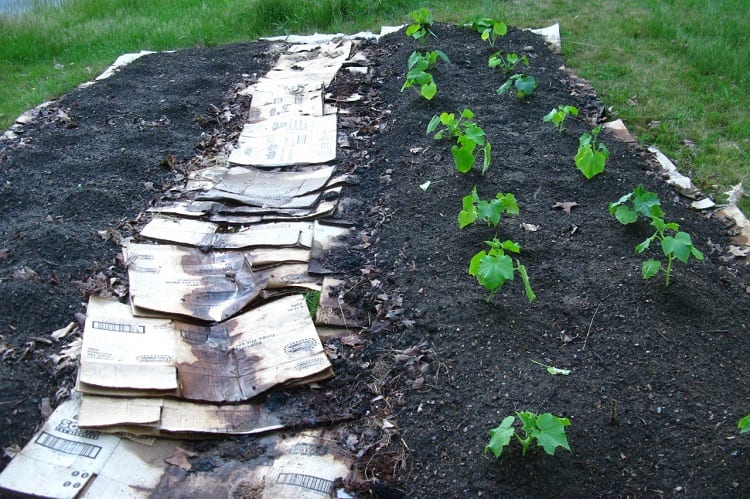
When springtime comes, you’re likely to see that the materials in your lasagna garden have taken on the appearance of a layer of loose material that looks a bit like compost. This is a good sign that they have decomposed and you’re ready to plant things in your garden!
To do that, dig into the lasagna garden in the same way you would in the rest of your garden. Just remember that if you’ve used cardboard as your foundation layer, you will have to cut holes in it so that you can plant.
How To Look After A Lasagna Garden
Now that you’ve planted things in your lasagna garden, you might be wondering how you need to maintain it. The good news is that you don’t have to do much! Here are some things you can do to keep your garden healthy.
- Regularly add mulch to the garden. This should take the form of grass clippings, chopped leaves, or straw.
- Water it when necessary, such as if it’s looking dry.
- Remove weeds from the garden as you see them. You can probably just do this by hand.
Pros And Cons Of Lasagna Gardening
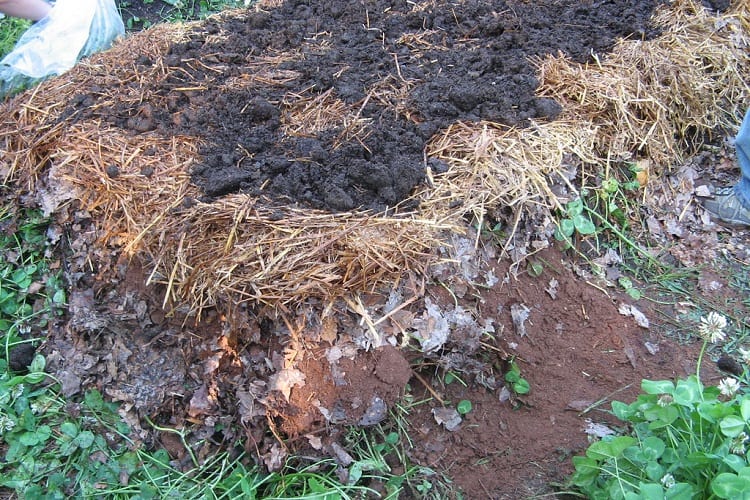
Although we’ve already seen that there are many benefits associated with having a lasagna garden, or even just a lasagna bed in your property, it’s important to note that there are also some potential drawbacks.
So, with that in mind, let’s check out advantages and disadvantages of growing your own lasagna garden.
Pros
- It can save you money. Not only will you save money on the gardening tools you would need in a regular garden, such as tillers, but you’ll also save money on purchasing bags of soil to enrich the health of your plants. You can make use of organic materials you already have in the home and garden.
- It can improve the quality of your soil. Lasagna gardening is an easy and natural way to boost the quality of your soil. This is because of how it’s designed. Since the layers of the lasagna garden are placed on top of the current soil, these can help to hold onto nutrients in the soil for longer periods of time than if you simply put fertilizer or compost on the soil.
- It’s a natural way to eliminate and prevent weeds. Weeds can be a real nuisance in the garden, but lasagna gardening can prevent them from growing because of how the cardboard or newspaper layer in the garden helps to block them. This is a much safer way to tackle weed problems than using herbicides that are dangerous to our health, that of our pets, as well as the environment.
- You don’t have to be experienced in gardening. It helps to know that you can easily set up a lasagna garden without having any gardening knowledge. Once it’s been set up, it does most of the work itself!
- Anyone can start a lasagna garden. Some types of gardening might be off limits if you have a mobility issue but since you don’t have to work the soil and put in a lot of effort to set up and maintain your lasagna garden, you’ll be able to create one easily. In addition, you can make it any height you like, which can also help if you battle to bend down because of a health condition. Having a tall lasagna garden can make it much easier to work with when required.
Cons
- You need a lot of material. Although the idea of being able to use your own organic materials to set up a lasagna garden is fantastic, it’s not always easy to do this because you might not have large enough amounts of the organic materials – both green and brown – that you need. This is especially the case if your household is small, doesn’t produce a lot of organic waste, or if your garden is small and doesn’t produce a lot of brown material.
- It takes a lot of time. Earlier, we mentioned that setting up your lasagna garden before the wintertime is a good idea because it gives the organic matter a chance to decompose. But it takes a long time for this to happen, so you have to be patient!
- Not all cardboard products are safe. You might love that you can use cardboard boxes as a source for the cardboard layer you need in your lasagna garden, but this might prove to be a drawback instead of an advantage. Many cardboard boxes that you have in the home could have dyes in them, such as cardboard boxes that originate from overseas. The problem with these dyes is that they will leak from the cardboard when it decomposes. Frighteningly, the cardboard could contain chemicals that could enter your plants, such as your vegetable plants, and result in spreading toxins. Just to make the matter worse, it’s impossible to know exactly what chemicals or petroleum products are in cardboard.
- You might not be able to create a large garden. While there’s no rule on how large your lasagna garden should be, you will have to think about its size practically. It all comes down to how much of the organic matter you’ll be able to source for the garden’s layers. If you don’t have a lot, then you’ll have to settle for having a really small lasagna bed. If you were hoping for a larger vegetable patch, for example, you might be left disappointed.
What Can You Grow In Your Lasagna Garden?
One of the best things to grow in your lasagna garden is heavy feeders – these refer to fresh produce such as peppers and tomatoes that are called heavy feeders because they want lots of nutrients in their soil. This is why they’ll thrive in a lasagna garden!
That said, you can grow more than vegetables and fruits. A lasagna garden is excellent for a range of different plants. These include herbs, cut flowers, and perennials.
How Much Will Your Lasagna Garden Cost?
Earlier, we mentioned that you can save money by investing in a lasagna garden. And, if you grow your own produce, that’ll also cut costs! However, you might be wondering what it will really cost for you to set up your own lasagna garden.
The amount will obviously vary, depending on how many items you already have that you can use for the organic matter layers. But, you’re in luck: setting up a lasagna garden is dirt cheap! The Spruce estimates it will cost you between $0 and $20!
This is because you only need to ensure that you have enough brown and green organic matter. While you could use the matter you already have at home, if you don’t have these then you’ll have to get them from somewhere else.
Now, before you go out and purchase lots of newspapers or cardboard, you can save money by checking with people in your local community if they have items to spare. This can further cut down your costs.
Once you’ve got your organic matter, you can set up your garden easily and without requiring any gardening tools! Maintaining your lasagna garden also doesn’t require tools.
You just need to ensure that you water it regularly so that the layers remain moist. Again, you’ll have to acquire green and brown organic matter that you can use to top up on your lasagna garden from time to time.
Do You Have To Wait For Spring To Plant In Your Lasagna Garden?
Maybe you’re impatient and can’t wait to use your lasagna garden before its organic elements have started to decompose. If that’s the case, you’re in luck – you can start planting in your lasagna garden immediately! However, it’s important to follow these steps:
- If you already have a plant you want to put into the garden, gently pull the layers of the lasagna garden apart so that you can make a hole for the plant to go into. Gently push the layers back to cover up the hole and water the garden.
- If, on the other hand, you want to plant seeds, you should spread a fine layer of damp peat moss or compost over the area where you want to put the seeds. Sprinkle your seeds and then cover them up with another fine layer of the compost or peat moss.
How Can You Turn A Regular Garden Bed Into A Lasagna Garden?
Maybe you have a gardening bed that you’ve already been using to grow flowers or veggies. Can you turn this into a lasagna garden? Absolutely! In fact, it will probably do your garden a world of good for it to be infused with more nutrients from organic matter.
To make the switch, you’ll need to do the following:
- In the late fall or early winter, you should cover the veggie garden or bed with thick layers of newspaper or cardboard. Make sure they have been wet beforehand.
- If you have a flower bed that you want to turn into a lasagna garden, make sure you pull up the plants before doing so.
- Then, simply create the lasagna garden layers as we outlined earlier in this article.
How To Start A Container Lasagna Garden
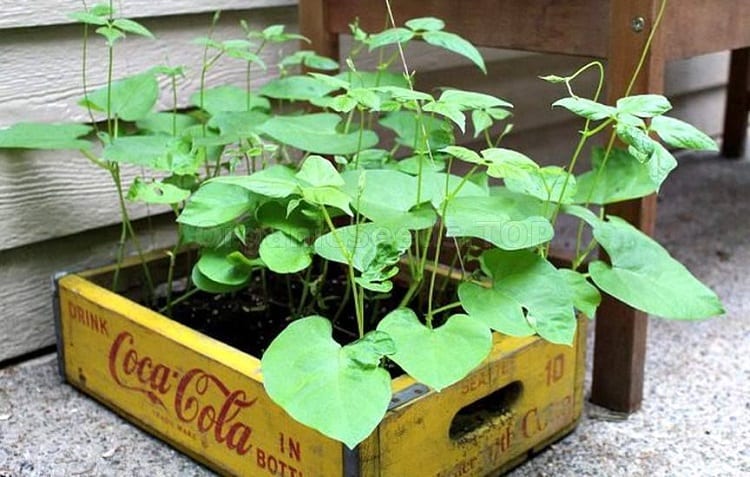
Earlier, we mentioned that a lack of space doesn’t have to be a deterrent if you want to create a lasagna garden.
If you don’t have enough space in your property you could use a greenhouse or go one step further and set up your own container lasagna garden. Yes, you can have a lasagna garden in a small container!
Here’s how:
- Choose the container you want to use in which to grow flowers or herbs, or whatever else. Obviously, consider the size of the container and how much space the plant will need.
- Then, cut up newspaper and wet it, before placing it at the bottom of the pot or other container.
- Fill the container with a two-inch layer of peat moss. You’ll also need to add a two-inch layer of potting mix.
- Then, take your brown and green organic materials and put in a layer or two of each.
That’s all you have to do! Now you can start planting!
Related Questions
Although fall is ideal, you can set up your lasagna garden in warmer weather but add topsoil or peat to the bed so that you can plant things in it immediately.
You should never use animal waste when setting up your lasagna garden. This is because this waste can be filled with harmful pathogens.
Conclusion
If you want an instant garden, lasagna gardening is a must to try! You certainly won’t be disappointed because you’ll be able to make use of organic items from your household to encourage plants and fresh produce to grow.
In this article, we’ve looked at this type of organic, sustainable gardening, highlighting its benefits, potential drawbacks, and showing you step by step how to start enjoying your own lasagna garden. It’s the fuss-free, no-effort garden that everyone should have!

